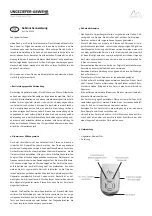
Becker VRP-B-CH Series Valve Regulator Pilot Instruction Manual | 14
© 2016 General Electric Company. All rights reserved.
Appendix
Flow Calculations
Critical Flow
Qc = 312.8 x P
1
x C
v
x
1
G x (T + 460)
Variables:
Qc = critical flow across the inlet orifice in scfh
P1 = supply pressure to the pilot in psig
Cv = 0.00447 x n
1.656242
G
= specific gravity of the gas
T
= temperature of the gas in °F
Steady State Consumption for downstream bleed*
*(<10 scfh for bleed to atmosphere)
Qssc = steady state consumption
Qc1 = critical flow across the top orifice in scfh
Qc2 = critical flow across the bottom orifice in scfh
Cv = 0.00447 x n
1.656242
n
= number of the orifice setting on orifice block (1 through 6)
Qssc = Q
c1
+ Q
c2
Supply Regulator Capacity
Qsrc = 2Qc
Variables:
Qsrc = supply regulator capacity
Cv = 0.0869 (calculated with n= 6)
Travel Time
Minimum travel time (the time the valve takes to move from one
extreme position to another) is achieved when the signal deviates
5% or operation. The monitor or standby regulator pilot travel time
is governed by the flow capability of the supply orifice. The control
valve pilot travel time is governed by the exhaust capacity of the
balanced valve. This is shown as t
1
below:
t
1
= 0.148 x
G
T + 460
S x D
2
C
v
x
a) Monitor/Standby pilot bleeding to atmosphere
or downstream:
Variables:
t
= time in seconds
S
= cylinder stroke in inches
D
= cylinder diameter in inches
Cv = flow factor (for orifice or booster)
b) Working pilot time from 50 percent open to either extreme:
t
= t
1
+ 0.0003906 x S x D
2
x P2
Gas Consumption Table
(1)
Suppy Gas
pressure
(psig or psid)
Orifice number
2
3
4
5
6
100
29
56
90
130
176
150
41
80
130
187
253
200
54
105
169
244
330
250
66
129
210
301
407
Consumption (SCFH) for monitor and standby valve. For figure
while in control, divide by 2.
(1)
ONLY APPLIES TO VRP-B-CH WHEN BLEEDING TO A PRESSURE
SYSTEM!















































